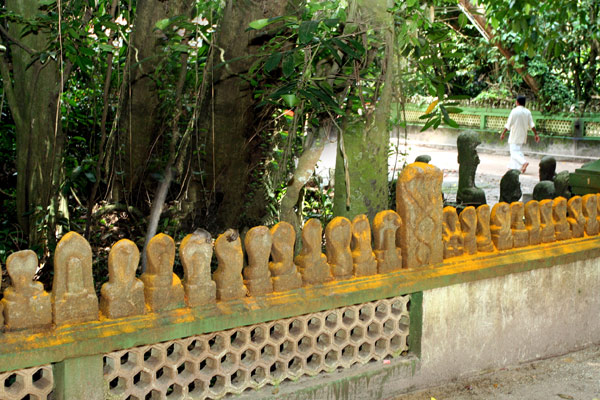Serpent worship in Kerala

The serpent temple at Mannarasala is the most famous in Kerala. There are over 300,000 serpent idols here.
Serpent worship is common among Hindus. It is particularly common among the Hindus of Kerala. According to legends, it was Parashurama (Rama with an axe – the 6th incarnation of Lord Vishnu) who started the worship of serpents in Kerala. He is also credited with the creation of Kerala. According to another very popular story, the land of Kerala rose from the seas when Parashurama threw his axe into it. However, this land that he reclaimed from the sea was not fit for habitation because of the affliction of snakes. There were too many of them. Also the salt content of the soil made it infertile. Parashurama became sad when the Brahmins whom he brought to live in Kerala deserted the place for fear of snakes. To resolve the issue he prayed to Lord Shiva who advised him to seek the blessings of Anantha (the king of snakes) and Vasuki (another very illustrious serpent). Pleased with his penance, they appeared before Parasurama and advised him to start the worship of serpents as the protectors of earth. They also urged him to build grooves where serpents could live and roam around freely. They then summoned King Cobras and urged them to desalinate the soil with their venom. Once the soil was desalinated, it became fertile. The snakes thus helped create God’s own country, the most beautiful place in the whole world.
Read about popular serpent temples in Kerala.
Kerala is a narrow strip of land lying between Arabian Sea and Western Ghats. At some point, the state had over 30000 sprawling snake grooves. Today, only about 5000 are left behind. As population increased, land became scarce and people started building homes in lots that were once serpent grooves. Unfortunately, this practice did considerable damage to the ecosystem and now the government of Kerala is working hard to preserve the remaining grooves.
Snake grooves were much more than the haunts of snakes. They were mini forests often spread over acres of land. Since no one dared to venture into them for fear of snakes, huge trees, plants, bushes and vines flourished in them. The abundance of medicinal plants growing in these grooves made them priceless treasures of nature. Most of these grooves typically also had a pond or another water body that ensured that the land surrounding the grooves was wet and fertile.
Back to history. In some ancient texts, the land of Kerala is described as Ahibhoomi (the land of snakes). Some ancient Tamil works also refer to Kerala as Nagalokam (the world of snakes).

Serpent idols at a Kerala temple. Serpent worship is very common among Malayalis.
There is a general belief that when serpents are worshipped, they will protect people from harm. Earlier women used to wear pendants, bangles and rings that have serpent shapes carved into them. Such ornaments are still widely used. While grooves are disappearing from the state, serpents are still worshipped and there are several temples dedicated to them.
What is a snake groove?
Ancient Kerala was full of snakes and hence uninhabitable. In order to gain relief from the affliction of snakes, Parashurama urged people to worship snakes. In those days when fewer people lived in the state each household owned acres of land. It was customary for each family to reserve a certain portion of their land – typically one or two acres – for the snakes. Each snake groove will have a small shrine with one or more idols of snakes. Since people almost never ventured into these grooves, snakes could freely roam around the area reserved for them. The absence of human intervention also helped the groove’s ecosystem. No one cut down the trees, bushes and vines growing in the groove. Prayers are occasionally offered at the shrine. It is also a common practice to light an oil lamp in front of the idols in the evening. The snake grooves are usually located in the south west corner (Kanni Moola) of the property. Even if no snake grooves are built in this area, Vastusasthra forbids toilets or garbage dumping in this corner.
It is believed that the worship of snakes would bring prosperity to the family. Women who are unable to conceive also pray for the blessings of serpents.
The curse of serpents
While it is easy to dismiss these beliefs as superstitions, they run deep in the psyche of a Hindu. The poisonous snakes found in snake grooves are typically harmless. They may occasionally venture outside of their grooves, but they do not normally bite people or cattle. Grooves foster an attitude of mutual benevolence between man and wildlife (snakes). No one kills the snakes of the grooves. People believe that King Cobras have the power to curse and families that invite their wrath will eventually perish. In Kerala, no one dares to destroy the snake grooves or desecrate their shrine. Before using the land for other purposes, families typically do penance and take the idols to another serpent temple. These idols are installed there and once a year family members pray at this temple seeking the blessings of the Nagaraja (the king of serpents). If the grooves are destroyed without following the due procedure, it will earn the destroyer and his family the wrath of serpents. While Muslims and Christians of Kerala do not worship snakes, they are also afraid of these reptiles. Most of them refuse to buy land that houses a groove.
Where to find snake grooves
Snake grooves are still found in most parts of Kerala; however, many of them now only contain a couple of trees and idols. Big snake grooves can be found in about 14 locations in Kumarakom.